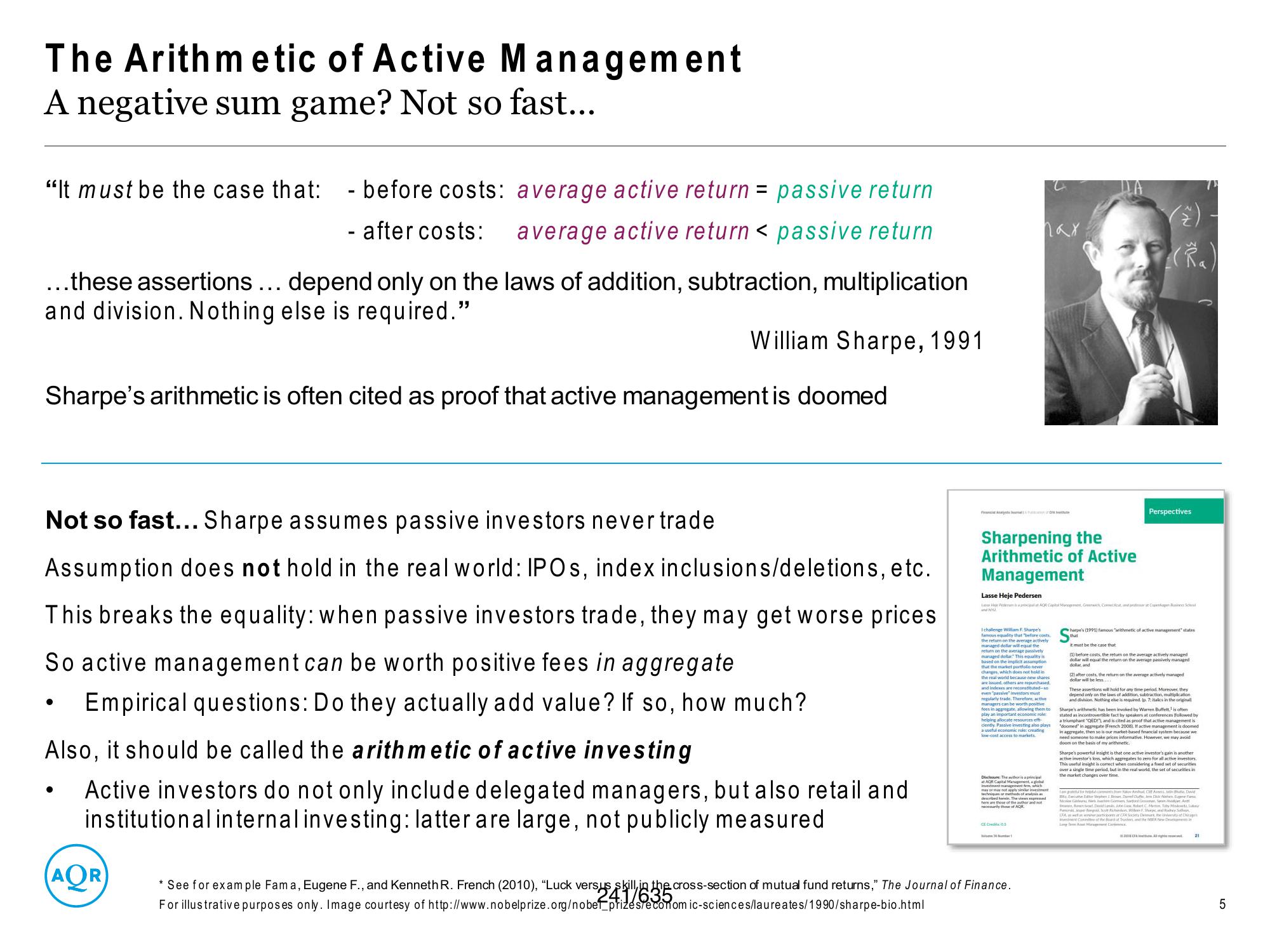Active and Passive Investing
The Arithmetic of Active Management
A negative sum game? Not so fast...
"It must be the case that: - before costs: average active return = passive return
- after costs: average active return < passive return
...these assertions... depend only on the laws of addition, subtraction, multiplication
and division. Nothing else is required."
Sharpe's arithmetic is often cited as proof that active management is doomed
William Sharpe, 1991
Not so fast... Sharpe assumes passive investors never trade
Assumption does not hold in the real world: IPOs, index inclusions/deletions, etc.
This breaks the equality: when passive investors trade, they may get worse prices
So active management can be worth positive fees in aggregate
Empirical questions: Do they actually add value? If so, how much?
Also, it should be called the arithmetic of active investing
Active investors do not only include delegated managers, but also retail and
institutional internal investing: latter are large, not publicly measured
●
(AQR)
P
Sharpening the
Arithmetic of Active
Management
and NY
пах
Lasse Heje Pedersen
Lalat AQR Capital Management Greenwich Connect, un progen Rino Somal
Ichallenge William F. Sharpe's
famous equality that "before costs.
the return on the average actively
managed dollar will equal the
return on the average passively
managed dollar. This equality is
based on the implicit assumption
that the market portfolio never
changes, which does not hold in
the real world because new shares
are issued, others are repurchased.
and indexes are reconstituted-so
even passive investors must
regularly trade. Therefore, active
managers can be worth positive
fees in aggregate, allowing them to
play an important economic role
helping allocate resources eff
dently Passive investing also plays
a useful economic role: creating
low-cost access to markets.
Die Theerthoris a principa
at AQR Capital Management, a dob
investment management firm, which
may or may not apply similar invest
tachometheads of analysis a
described in The views expressed
necessarily those of A
CEC05
* See for example Fama, Eugene F., and Kenneth R. French (2010), "Luck versus skill in the cross-section of mutual fund returns," The Journal of Finance.
41/635
For illustrative purposes only. Image courtesy of http://www.nobelprize.org/nobel prizes economic-sciences/laureates/1990/sharpe-bio.html
(Ra)
Perspectives
harpe's (1991) famous "arithmetic of active management states
it must be the case that
(1) before costs, the return on the average actively managed
dollar will equal the return on the average passively managed
dollar, and
(2) after costs, the return on the average actively managed
dollar will be less
These assertions will hold for any time period. Moreover, they
depend only on the laws of addition, subtraction, multiplication
and division. Nothing else is required. (p. 7: italics in the originall
Sharpe's arithmetic has been invoked by Warren Buffett is often
stated as incontrovertible fact by speakers at conferences followed by
a triumphant "QED!"), and is cited as proof that active management is
"doomed" in aggregate (French 2008). If active management is doomed
in aggregate, then so is our market-based financial system because we
need someone to make prices informative. However, we may avoid
doom on the basis of my arithmetic.
Sharpe's powerful insight is that one active investor's gain is another
active investor's loss, which aggregates to zero for all active investors.
This useful insight is correct when considering a fond set of securities
over a single time period, but in the real world, the set of securities in
the market changes over time.
fdcom
Anbu C Ashute Devid
Tttarita rosur Mms Clickr
MG Com Sartond Se
Devid Jon Debet C Martin Tidy Moireet, Li
Pe Bag Scotchon Wien F. Sharpe, S
Articipo a CFAS Det the sty at Drag
ere Come ant at the New Desi
Larg:amaCurt
21
LO
5View entire presentation